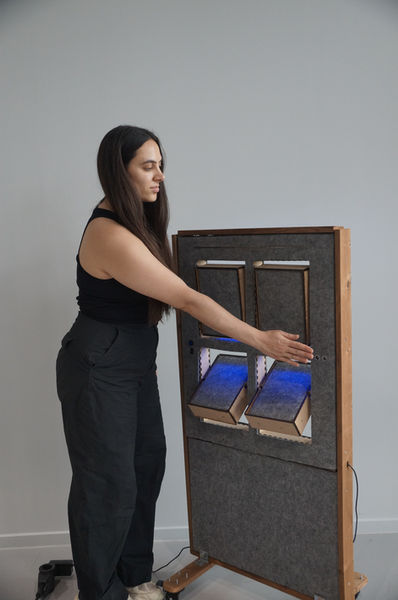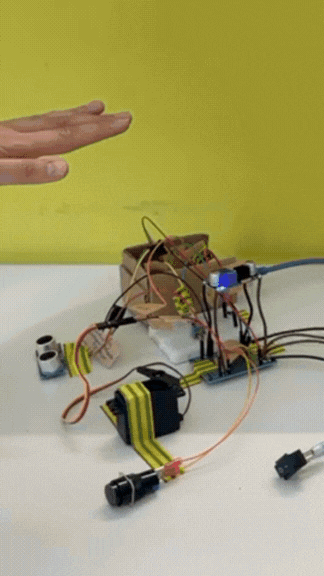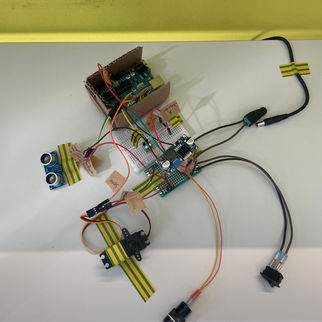I focus on
Business & Entrepreneurship (B&E)
User & Society (U&S)
Part of the
Research, Design & Development Track
In my Final Master Project (FMP), I followed the Research, Design and Development [1] track, focusing on user-centered design and real-world relevance. My project explores social dynamics in coworking spaces, reimagining how subtle interventions can support social interaction, communication and productivity through a mix of interactive, tangible and ambient elements.
To ensure my design was relevant and meaningful in real-word I seek for external collaborations. I initially contacted many companies, from which none replied. That is why eventually, I focused on Microlab, a well-known coworking provider in Eindhoven, insisted and approaching them through multiple channels. When we met, I had to persuade them that my research would benefit them, for which I created a small pitch. Now I see how challenging it can be to find, approach and persuade real stakeholders, who are willing to help. Visiting Microlab and conducting interviews, and ethnographic research, directly engaging with employees and users helped me understand daily routines, social dynamics, and challenges, to empathise with users before I start designing [2].
Later in the process, I felt the need to involve experts. I first reached out to other students working on similar topics, who advised me to contact Ahrend and the Workplace Vitality Hub, which led to a valuable collaboration. This made me realize the strength of the design community and how important it is to be open about your project, since in my previous studies it was more individualistic. Ahrend gave me insightful perspectives through weekly meetings and interviews with students and experts from different departments. Visiting their factory gave me a clearer sense of realistic design, scalability and office aesthetics by showing how design decisions translate into manufacturing and what it takes to move from prototype to production.
Evaluate
Develop
User Centered Design Process
Concept
Research
Design
'Co-Net'
An Interactive Room Partition
Supporting Social Engagement and Subtle Communication in Co-working spaces.

User & Society
Persona Creation
Involving Stakeholders in the design process
- Users & Customers Interviews
Stakeholder Analysis
Evaluation
- User Tests (Role-play) & Expert Involvement (Co-Constructive Stories)
User Observation - Ethnographic Research
Focusing on user connectedness and well-being
I followed a user-centered approach, involving stakeholders from early concepts to final validation. I used methods like ethnographic observations [3], interviews, and roleplay-based [4] testing, techniques I learned in “Design for Social Innovation” and “User Experience Theory and Practice”. After the ethnographic phase, I conducted a stakeholder analysis and created personas, which defined user needs and revealed the different people involved, especially useful in role-play testing and when exploring the project’s business approach later on.
These methods helped me understand and empathise with users, evaluate the concept and assess whether the prototype met its goal. In the final phases, I used co-constructive stories [5], a new method for me, which sparked valuable conversations about the concept’s potential and its fit in real-world contexts.
These activities helped me grow as a designer, equipping me with a more holistic view of user-centered practices, while also fulfilling my goal to explore human relations and design a product that fosters community and connectedness [6].
Technology and Realisation
To build my prototype, I began with brainstorming, sketches and prototype explorations, supported by detailed 3D models in Rhino for the realization of the prototype. It was the first time turning a concept into a full-scale interactive prototype on my own, integrating electronics and carefully planning assembly, disassembly and component placement.
Lo-Fi experimental Prototyping

Building and Unbuilding the Prototype
I explored various servo casings, rotation mechanisms and connections, to find the best stable designs to support the movements. Challenges occur three days before DemoDay when the 3D-printed mechanism broke, forcing me to disassemble, repair and reassemble everything, losing valuable time. This made me realize that I should test different materials before settling on one. The mid-fidelity version worked, but I did not expect final to fail due to its weight. Using 3D printing was not the smartest choice, if I had used metal from the beginning, it would have been stronger and allowed me to experiment more with shapes, sizes and aesthetics of the whole prototype.



Math, Data and Computing
Since I aimed to work on tangible designs, Math, Data and Computing became inevitable. Although it is not my strongest expertise, I built a solid foundation through electives. For this project, I wrote and modified Arduino-based code to control the system of electronics, learning how to select components, connect and calibrate, to deliver the desired interaction. While facing challenges with burning components, connections or programming, I reached out to friends and D.SearchLab employees for feedback, gradually building the final code. This development made me realise the new innovative design opportunities that embedding technologies can bring. While there is still room to grow, I now have the technological foundation to explore design possibilities and know how to collaborate with other professionals in the future.

Business & Entrepreneurship
Even though business was new to me, I applied knowledge from electives to approach the design as a service [7]. Starting with stakeholder analysis and personas linked to the Business Model Canvas, I defined the ideal direction and next steps for feasibility [8], [9], [10]. I also conducted competitor analysis to identify gaps and potential in the market. By involving providers, users, and experts early, I evaluated the problem and gathered feedback on feasibility, materials and costs. Ahrend’s involvement helped align the project with their business model by applying the “furniture as a service” approach [7] and understanding its value though the Value Hill framework [11].
Creativity and Aesthetics
Throughout the development process, I iteratively mapped forms, functions and interactions, shaping both the concept and the expressivity of the prototype [12]. The visual identity follows market trends to fit the coworking context while remaining functional and visually pleasing. I investigated Ahrend’s design language and manufacturing drawings to better align with their approach. Inspired by architectural simplicity and neutral palettes, the design blends into existing interiors but stands out during interaction, just like the divider with user’s attention, where the divider stays in the periphery and moves to the centre of attention only when needed [13]. At DemoDay, I presented the interactive prototype in an exhibition-like setup designed to resemble a desk divider itself, using office-inspired colours and inviting visitors to engage with the system and share feedback.

Skills
User & Society
Business Entrepreneurship
Technology & Realisation
Math, Data & Computing
Creativity & Aesthetics
This semester, I explored interactive prototyping, user-centered research methods and turning abstract ideas into feasible solutions. Through the collaboration with Ahrend, I practiced presenting to professionals, which felt challenging, especially as English is not my first language. Weekly presentations to students and experts helped me build a clear visual narrative, trust my direction and refine it further. Working independently improved my organization, communication and persuasion skills, while also strengthening practical skills like structured brainstorming and technical skills like 3D modelling, coding and prototyping.
Throughout this project, I carried my Architecture background, blending it with Industrial Design principles, moving beyond designing spaces, focusing on interaction, user behaviour and feasibility. Industrial Design equipped me with a more holistic perspective, something I felt missing in Architecture, which often takes a first-person perspective and does not always consider the users and business aspect which is so important in the real market.
This master’s helped me define, evaluate and refine my work using methodologies, while learning how to design iteratively and involve stakeholders throughout the process. Collaborating with designers from different backgrounds and influences helped me appreciate the value diverse opinions, which can lead to innovative ideas. Now thinking beyond how something looks or works, towards how it fits into the market, meets real user needs and creates value, evolving from a spatial designer who designed for users, to an experience designer that designs with them.
References
[1] R. C. Richey and J. D. Klein, ‘Design and development research’, in Handbook of research on educational communications and technology, Springer, 2013, pp. 141–150.
[2] Interaction Design Foundation - IxDF., ‘What is User Centered Design (UCD)?’, Interaction Design Foundation - IxDF., May 2016. Accessed: Jun. 10, 2025. [Online]. Available: https://www.interaction-design.org/literature/topics/user-centered-design
[3] H. Gusterson, ‘Ethnographic research’, in Qualitative methods in international relations: A pluralist guide, Springer, 2008, pp. 93–113.
[4] ‘Role Play’, Think Des., Accessed: May 19, 2025. [Online]. Available: https://think.design/user-design-research/role-play/
[5] C. J. Patti and C. Ellis, ‘Co-Constructed Interview’, in The International Encyclopedia of Communication Research Methods, John Wiley & Sons, Ltd, 2017, pp. 1–2. doi: https://doi.org/10.1002/9781118901731.iecrm0026.
[6] D. Bel, K. Smolders, W. Ijsselsteijn, and Y. De Kort, ‘Social connectedness: Concept and measurement’, Jan. 2009, pp. 67–74. doi: 10.3233/978-1-60750-034-6-67.
[7] ‘Furniture as a Service’, Ahrend. Accessed: May 29, 2025. [Online]. Available: https://www.ahrend.com/nl/diensten/furniture-as-a-service/
[8] R. Brugha and Z. Varvasovszky, ‘Stakeholder analysis: a review’, Health Policy Plan., vol. 15, no. 3, pp. 239–246, 2000.
[9] A. Murray and V. Scuotto, ‘The business model canvas’, Symphonya Emerg. Issues Manag., pp. 94–109, 2015.
[10] A. Cooper, The Origin of Personas. 2008. Accessed: May 14, 2025. [Online]. Available: https://www.bibsonomy.org/url/ee9af986021b86129a7b07c02176e52a
[11] A. Heideveld, J. Kerkhof, A. Fischer, and B. Ahsmann, ‘Master Circular Business with the Value Hill with the Circle Economy & Sustainable Finance Lab.’, 2016. Accessed: Jun. 01, 2025. [Online]. Available: https://www.circle-economy.com/resources/master-circular-business-with-the-value-hill
[12] M. Bruns, S. Ossevoort, and M. G. Petersen, ‘Expressivity in Interaction: a Framework for Design’, in Proceedings of the 2021 CHI Conference on Human Factors in Computing Systems, in CHI ’21. New York, NY, USA: Association for Computing Machinery, 2021. doi: 10.1145/3411764.3445231.
[13] S. Bakker, E. van den Hoven, and B. Eggen, ‘Peripheral interaction: characteristics and considerations’, Pers. Ubiquitous Comput., vol. 19, no. 1, pp. 239–254, Jan. 2015, doi: 10.1007/s00779-014-0775-2.





























